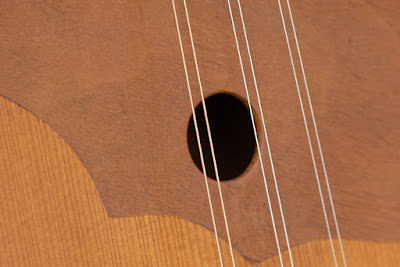1930s Romanian-made Reghin 6-String Balalaika
I'm not certain about the age of this instrument, though I do know that the hardware dates to pre-WWII. It's possible this is a 1930s-era instrument but it's also possible it's a postwar instrument fitted-out with older parts (the tuners are 20s/30s era Germany-stamped mandolin strips cut down to fit) I'm guessing that, judging by the nicer build quality (compared to most postwar balalaikas) that it's older, though.
It came in more or less ready-to-go but it did need a fret level/dress, setup, and bridge shave/adjustments. The center seam on the top had already been glued-up in the past and a chip-out on the rosewood edge binding on the bottom had been filled as well.
I changed the stringing from normal balalaika tuning (E-E-A is what's often used on the 3-string variety and G-B-D in the same range as open-G guitar's top strings is common on this 6-string variety) to an open G modal chord (G-D-G) using mandolin strings (24w-14-10) which can be retuned to the G-B-D tuning by jumping up the plain gauges to 17-13. It plays like a mountain dulcimer in this tuning. I'd originally strung this with octaves in a bizarre tuning but I find the instrument likes this range and style much better (as it's closer to traditional pitch).
It came in more or less ready-to-go but it did need a fret level/dress, setup, and bridge shave/adjustments. The center seam on the top had already been glued-up in the past and a chip-out on the rosewood edge binding on the bottom had been filled as well.
I changed the stringing from normal balalaika tuning (E-E-A is what's often used on the 3-string variety and G-B-D in the same range as open-G guitar's top strings is common on this 6-string variety) to an open G modal chord (G-D-G) using mandolin strings (24w-14-10) which can be retuned to the G-B-D tuning by jumping up the plain gauges to 17-13. It plays like a mountain dulcimer in this tuning. I'd originally strung this with octaves in a bizarre tuning but I find the instrument likes this range and style much better (as it's closer to traditional pitch).
The spruce top is made from 4 pieces and has a nice inlaid wooden "pickguard."
The neck, back and sides are all made from slightly-figured maple. The nut, body binding, and board are all made from rosewood.
Pretty, huh? I like having the extension over the body and that nice "marquetry" purfling.
The top is simply ladder-braced.
I used a 20s-era banjo bridge (compensated) when setting this up for the G-D-G/G-B-D stringing. The original all-maple bridge is stowed with the instrument.
I used a 20s-era banjo bridge (compensated) when setting this up for the G-D-G/G-B-D stringing. The original all-maple bridge is stowed with the instrument.
The tailpiece is a type I'm used to seeing on German and Italian mandolins from the 1920s-1930s.
Unlike many balalaikas, the heel is rounded like a mandolin rather than adorned with a "volute." It feels more natural to my hand, at any rate.
There are those old 20s/30s German mandolin tuners (brass plates) cut down.
There's a filled patch where the rosewood binding was chipped-out, here...
...but the other side is normal.


















Comments